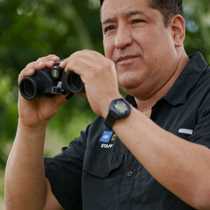Santiago Island
With the arrival of the rainy season Santiago Island has already become green, new leaves are covering trees and bushes giving this island a fresh appearance. Land birds are busily protecting their territories, collecting nesting material and even mating! It is a natural process that gets repeated year after year, with the islands having two seasons: a warm-wet season and a cool-dry one. To start the day off, we had an early walk on Espumilla Beach. The highlight of this wonderful outing, in addition to the mangrove forest at the beach, was the fabulous view from up the little hill that crowns the trail filled with mature “Palo santo” trees and a marvellous choir of Darwin finches.
Later on, during breakfast, the ship was repositioned to Buccaneers’ Cove. This historical place was once a favorite location for pirates and privateers, as they could find here fresh water, firewood, good anchorages and tortoise meat. Nowadays Santiago Island is under the protection of the Galápagos National Park in order to preserve its Flora and Fauna and its ecosystems. Lindblad Expeditions plays a big role in the conservation of the entire archipelago, but Santiago Island is very special. It was adopted by the company several years ago in helping the Galápagos National Park service with vital funds used to successfully eradicate feral pigs and goats from the island.
Many activities were planned around the bay to give our guests the opportunity to do what they like most this morning. Snorkelling was an outstanding experience, for we saw many different tropical fish species including several eagle rays and white tipped reef sharks. Kayakers and Zodiac cruisers had a blast as well sharing the shores with marine iguanas, sea turtles and watching boobies and pelicans plunge diving to catch fish – all with a backdrop of the impressive walls of a huge tuff cone.
In the afternoon, National Geographic Islander took us to the western coast of Santiago Island. After lunch and a Darwin talk we disembarked and began a walk of discovery of the wonders of Puerto Egas. A light rain felt during the whole walk, so we all were wet at the end, but the afternoon was simply gorgeous. We took the seaside trail along the coastline. We observed dozens of marine iguanas under the drizzle. The trail ends up into the carved sea-level grottos where we could see several Galápagos fur seals resting inside the lava tubes and showing their very distinctive features that correspond to these species. This species almost became extinct due to intensive hunting in the late eighteen hundreds.
Late in the afternoon, we had to head back to the ship. It was an unforgettable day, a different one by all means; today we were given a new chance to understand the complexities of this remote and isolated enchanted group of islands. We can hardly wait to see what new discoveries and feelings our expedition will bring tomorrow to our lives!




